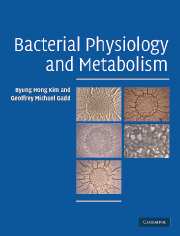Book contents
- Frontmatter
- Contents
- Preface
- 1 Introduction to bacterial physiology and metabolism
- 2 Composition and structure of prokaryotic cells
- 3 Membrane transport – nutrient uptake and protein excretion
- 4 Glycolysis
- 5 Tricarboxylic acid (TCA) cycle, electron transport and oxidative phosphorylation
- 6 Biosynthesis and microbial growth
- 7 Heterotrophic metabolism on substrates other than glucose
- 8 Anaerobic fermentation
- 9 Anaerobic respiration
- 10 Chemolithotrophy
- 11 Photosynthesis
- 12 Metabolic regulation
- 13 Energy, environment and microbial survival
- Index
- References
6 - Biosynthesis and microbial growth
Published online by Cambridge University Press: 05 September 2012
- Frontmatter
- Contents
- Preface
- 1 Introduction to bacterial physiology and metabolism
- 2 Composition and structure of prokaryotic cells
- 3 Membrane transport – nutrient uptake and protein excretion
- 4 Glycolysis
- 5 Tricarboxylic acid (TCA) cycle, electron transport and oxidative phosphorylation
- 6 Biosynthesis and microbial growth
- 7 Heterotrophic metabolism on substrates other than glucose
- 8 Anaerobic fermentation
- 9 Anaerobic respiration
- 10 Chemolithotrophy
- 11 Photosynthesis
- 12 Metabolic regulation
- 13 Energy, environment and microbial survival
- Index
- References
Summary
Chapters 4 and 5 describe and explain the anabolic reactions that supply carbon skeletons, reducing equivalent (NADPH) and adenosine 5′-triphosphate (ATP) needed for biosynthesis. This chapter summarizes how the products of such anabolic reactions are used in biosynthesis and growth, ranging from monomer synthesis to the assembly of macromolecules within cells. Chemoheterotrophs, such as Escherichia coli, use approximately half of the glucose consumed to synthesize cell materials while the other half is oxidized to carbon dioxide under aerobic conditions.
Molecular composition of bacterial cells
The elemental composition of microbial cells was discussed in Chapter 2 in order to help understand what materials the bacteria use as their nutrients. These elements make up a range of molecules with various functions. Cellular molecular composition varies depending on the strain and growth conditions. As an example, Table 6.1 lists the molecular composition of Escherichia coli during the logarithmic phase when grown on a glucose–mineral salts medium. The moisture content is over 70%, and protein is most abundant, occupying 55% of the dry cell weight, followed by RNA at about 20%. It is understandable that proteins are abundant since they catalyze cellular reactions. The DNA content is least variable, while the RNA content is higher at a higher growth rate. Not shown in Table 6.1 are storage materials, such as poly-β-hydroxybutyrate and glycogen, which vary profoundly within cells depending on growth conditions, and can comprise up to 70% of the cell dry weight (Section 13.2).
- Type
- Chapter
- Information
- Bacterial Physiology and Metabolism , pp. 126 - 201Publisher: Cambridge University PressPrint publication year: 2008
References
- 1
- Cited by



